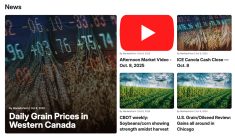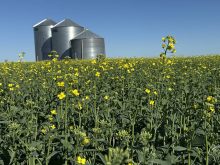Hogs
Pork stocks bigger
United States pork belly stocks at the end of July were 25 percent lower than in June, but were still more than double last year’s levels.
Total stocks of pork were down by six percent from a month earlier, but were up 21 percent from last year.
Large stocks of pork and increasing hog slaughter last week resulted in falling hog prices.
Less than four percent of U.S. packers’ hog kill is purchased from public markets, so even though cash prices declined, the prices plants paid for hogs remained fairly stable.
Read Also

Huge Black Sea flax crop to provide stiff competition
Russia and Kazakhstan harvested huge flax crops and will be providing stiff competition in China and the EU.
The Iowa-southern Minnesota price (plant top, 51-52 percent lean, live equivalent) was $43.25 (U.S.) per hundredweight almost all week.
Manitoba Index 100 hog prices were estimated at $146 per 100 kilograms for the week.
Heifers paying more
Fed steer prices were steady and heifers were 50 cents to $1 per hundredweight higher than the week before.
Canfax said the heifer price premium is becoming more consistent as overall carcass weights move higher.
Last week’s steer weight was 811 pounds, 11 lb. heavier than last year.
The heaviest weights typically don’t come until September and October.
Normally, heavier cattle are shipped to packers in the U.S., but the anti-dumping duty has put a stop to that.
Prices Aug. 26 were steers $88.50-$89.50, flat rail $147.40-$148.10 and heifers $86.70-$89.50, flat rail $148-$150.
Canfax said beef movement is good heading into the Labor Day weekend, but buyers are expected to take a “wait and see” attitude for post Labor Day sales.
Wholesale prices climbed higher with the Calgary wholesale market up $2 for this week, putting handyweight steers in a range of $149-$157 per cwt.
The large number of cattle marketed at the end of last week was expected to result in lighter numbers this week, which is good, considering buyers would be buying for the following short week.
Packers will likely continue to move toward a two-tiered pricing system with heavyweights discounted and more premiums on heifers.
Cows were $2-$4 per cwt. lower last week on adequate supplies. The summer price peak has occurred and the fall slump has begun, although there might be a slight improvement in prices in mid-September if the harvest keeps cows from coming to town.
Feeder cattle traded steady to stronger last week.
Demand continues strong.
Canfax expects fewer yearling numbers again this year, keeping strong buyer interest in the calves.
Yearling prices were $1-$3 per cwt. higher while calves were steady to $5 higher depending on the region and offering.
Canfax said demand is expected to remain strong for all types of feeder cattle with overall volumes on the increase into the fall.
Bred cows ranged from $700-$1,020 on few sales. A few bred heifers were sold at prices from $800-$1,020. Cow-calf pair prices ranged from $1,000-$1,525.
















